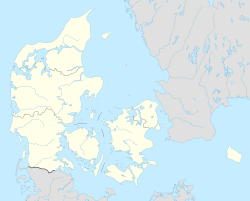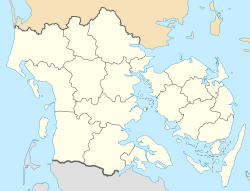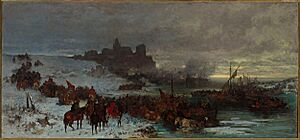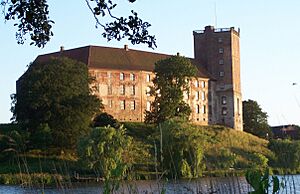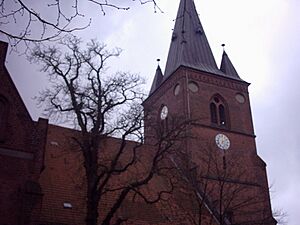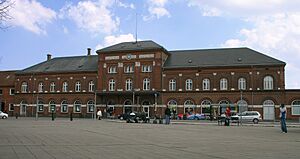Kolding facts for kids
Kolding (pronounced "KOL-ding") is a lively Danish seaport town located at the top of Kolding Fjord. It's a key spot for transportation, business, and making things. Many companies here focus on building ships, but they also make machinery, textiles (like fabrics), and export farm animals.
Kolding is part of the "Triangle Region" along with the nearby cities of Fredericia and Vejle. The city itself has about 62,444 people, making it the eighth largest city in Denmark. The whole Kolding area (municipality) has about 94,932 people.
Quick facts for kids
Kolding
|
||
|---|---|---|
|
Town
|
||
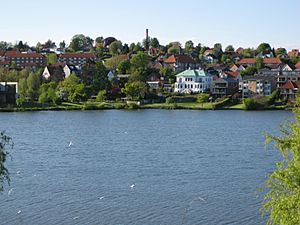
Castle Lake (Slotsø) in Kolding
|
||
|
||
| Country | Denmark | |
| Region | Southern Denmark (Syddanmark) | |
| Municipality | Kolding | |
| First documented | 1231 | |
| Area | ||
| • Urban | 38.3 km2 (14.8 sq mi) | |
| Elevation | 50 m (160 ft) | |
| Population
(2024)
|
||
| • Urban | 62,444 | |
| • Urban density | 1,630.4/km2 (4,223/sq mi) | |
| • Gender | 30,854 males and 31,590 females | |
| Demonym(s) | Koldingenser, Koldinger | |
| Time zone | UTC+1 (CET) | |
| • Summer (DST) | UTC+2 (CEST) | |
| Postal code |
6000
|
|
| Area code(s) | (+45) 7 | |
Contents
History of Kolding
Kolding has a long history, with its first mention in records dating back to 1231.
Battles and Events
In 1369, the Koldinghus castle was attacked and likely taken over by forces from Holstein.
A famous battle, the Battle of Kolding, happened on December 25, 1658. In this battle, Polish and Danish soldiers, led by Stefan Czarniecki, defeated the Swedish army.
Another battle between German and Danish forces took place near the town on April 23, 1849, during the First War of Schleswig.
On September 9, 1955, a strong tornado hit Kolding. It was powerful enough to move a car 20 meters!
A sad event occurred on November 3, 2004, when a fireworks factory in the suburb of Seest exploded. One firefighter lost their life, and many people were injured. About 2,000 people had to leave their homes, and some lost them completely.
Places to See in Kolding
Kolding is home to some amazing historical sites and museums.
Koldinghus Castle
The old royal castle of Koldinghus is located in Kolding. It was built in the 13th century by King Eric Klipping. Today, it's a museum, but parts of it, like the chapel and hall, are still used for important government events. It was the last royal home in the Jutland region of Denmark.
Church of Saint Nicholas
Another important old building is the 13th-century stone Church of Saint Nicholas (called Sankt Nicolai in Danish). It's one of the oldest churches in Denmark.
Museums and Gardens
The municipal museum, called Museet på Koldinghus, is inside the castle. It has a collection of Danish art from the late Middle Ages up to the 1940s. You can also see local historical items and a large collection of gold and silver objects.
The Trapholt art museum shows many artworks, mostly by Danish artists, from the 1900s onwards. It also has a smaller number of international pieces and a huge collection of chairs!
If you love nature, visit the botanical garden Geografisk Have. It's a large park, about 14 hectares (which is like 28 football fields!). It has over 2,000 different types of trees, bushes, and plants, organized by where they come from in the world.
Kolding also has the Danish Museum of Nurses (Dansk Sygeplejemuseum). It's in the building that used to be a special hospital for children with tuberculosis. The museum also shares the history of these buildings. The main part of the old hospital is now a hotel, set in a small forest with a view of the water. The building itself looks like a beautiful palace.
Education in Kolding
Kolding is a place where you can get a good education.
You can find a campus of University College South here.
The University of Southern Denmark also has a campus in Kolding. A new building for the university opened downtown in 2014.
Kolding is also home to Design School Kolding (Designskolen Kolding). This university-level design school was started in 1967. It offers degrees in areas like fashion, graphic design, and textiles.
Transportation
Kolding has its own Kolding railway station. From here, you can catch trains to many big cities like Copenhagen, Hamburg, Aarhus, and Esbjerg. There are also local trains to nearby towns.
Notable People from Kolding
Many interesting people have come from Kolding. Here are a few examples:
- Anne Marie Carl-Nielsen (1863–1945): A famous Danish sculptor.
- Bent Faurby (born 1937): An author who writes books for children.
- Jan Mølby (born 1963): A well-known football player and coach who played for Denmark's national team.
- Kasper Asgreen (born 1995): A professional cyclist.
Images for kids
See also
 In Spanish: Kolding para niños
In Spanish: Kolding para niños



